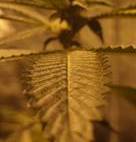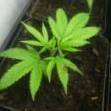All Activity
- Yesterday
-
Adellwal started following FF Premium Problems
-
Adellwal joined the community
-
uborka_nwMa started following FF Premium Problems
-
Greene Street Lakview Dr changed their profile photo
- Last week
-
Totemic changed their profile photo
-
Jауrtwene started following FF Premium Problems
-
NeonAqua started following Earthworm Bin Composter
-
You can not buy fertiliser that's this good: you've got to make it! Bin all your food scraps & make gold. This container produces both compost (fertiliser) tea and solid fertiliser (it automatically separates for your convenience). I will include all the instructions needed to take super good care of the earthworms. Very low maintenance (almost none)! The container is super full of earthworms. Complete setup at a very good price! Reason for selling: I don't have any plants to feed...
- Earlier
-
steelersfanthany started following FF Premium Problems
-

Most seed resistant strains
SkunkPharm replied to Dr Feelgood's question in General Questions & Answers
You could try the Super Cheese cut from Dagga Farmacy. I had it in a tent with males to try and pollinate it. I was unsuccessful. -
Hi everyone! Phlizon Grow Light 420 Sale is going alive! Sale up to 20% OFF! Check Phlizon Online stores below to get your grow light: Phlizon US store: https://www.phlizonstore.com/ Phlizon UK store: https://www.phlizon.co.uk/ Phlizon EU store: https://phlizon.eu/ Phlizon AU store: https://phlizon-au.com/ Phlizon CA store: https://www.phlizon.ca/ No tax, with free shipping from the local warehouse Fast delivery 5-7 business days 3-year Warranty, 30-day Free Return
-
NeonAqua started following White Rectangular Grow Box on Wheels
-
Dimensions: 61cm(L)x42cm(W)x89cm(H) Grow Box has wheels fitted for easy & convenient mobility. Made from pressed wood. Can quickly & easily be spray painted to any other colour, decorated or you can even apply vinyl / wallpaper. Includes: Reflective Shelf (it currently fits as a top shelf, but you can modify that according to your needs). 2 Point plug 12V Power Adaptor for the x2 fans. Please contact me on Telegram / Whatsapp!
-
Thank you! It's wonderful to be part of the community.
-
Serenity Moon changed their profile photo
-
TheDokta420 started following Kingbrite Quantum Board LED lm301H
-
Comes with receipt from futurama. Used for 1 grow. Perfect condition.
-
Jirrtwene started following West Coast OG Auto - selfie seed run
-
tCheck 2 Cannabis Infusion Potency Tester tCheck 2 is a device that brings cannabis infusion potency testing to the home. The ability to test alcohol based tinctures, olive oil, butter, and ghee. From the start to finish, tCheck 2 takes 45 seconds to test your potency.
-
The exact same thing (yellowing of leaves between the veins) happened to me using Freedom Farms soil. I would pH my water, and then get rid of the Chlorine, by using an air pump. It looked like a Magnesium deficiency. Then one day I tested my water, and the pH was soo high, off the charts. It turns out, bubbling water raises the pH, because it gets rid of the CO2. I had to re-pH my water. I was getting nutrient block out, hence Magnesium deficiency. Why did it take me so long to learn this. I hope this helps somebody else.
-
Source CBD Vape Pens UK: Are They Safe for Long-Term Use? Source CBD vape pens have gained popularity in the UK as a quick and convenient way to experience the benefits of cannabidiol (CBD). Many users turn to vaping as an alternative to traditional smoking or other forms of CBD consumption. However, as the trend grows, so does the concern about its long-term safety. Are CBD vape pens safe for extended use? Let’s explore the facts, potential risks, and benefits. Understanding CBD Vape Pens and Their Ingredients CBD vape pens are small, portable devices that allow users to inhale CBD-infused vapor. These pens contain a battery, a heating element, and a cartridge filled with CBD vape juice. CBD vape juice UK products typically include CBD extract, vegetable glycerin (VG), propylene glycol (PG), and sometimes flavorings. While these ingredients are considered safe for inhalation in the short term, their long-term effects require further research. You can buy the best CBD products online in UK from here https://cbdfx.co.uk/collections/cbd-vape-juice. Potential Benefits of Using CBD Vape Pens Many users choose CBD vape pens for their potential benefits, such as: Fast Absorption: Vaping CBD allows the compound to enter the bloodstream quickly, providing rapid relief for those using it for pain, anxiety, or stress. Convenience: Vape pens are easy to use and portable, making them a discreet option for CBD consumption. Customizable Dosing: Users can control their CBD intake by adjusting the number of puffs taken. These advantages make CBD vape pens an appealing option, but their long-term impact remains a topic of discussion. Are CBD Vape Pens Safe for Long-Term Use? 1. Effects of Prolonged Inhalation While CBD itself is generally considered safe, the other ingredients in vape juice, such as PG and VG, can pose potential health risks when inhaled over time. Some studies suggest that heating these substances can produce toxic byproducts, including formaldehyde and acetaldehyde, which may irritate the lungs. 2. Respiratory Health Concerns Regular vaping can lead to respiratory issues such as coughing, throat irritation, and shortness of breath. Long-term exposure to certain compounds in vape juice may contribute to lung inflammation, though more research is needed to determine the full extent of these effects. 3. The Risk of Contaminants Not all CBD vape products are created equal. Some lower-quality brands may contain harmful contaminants, including pesticides, heavy metals, and synthetic additives. In the UK, reputable brands must adhere to strict regulations, but consumers should always verify third-party lab testing before purchasing a product. 4. Nicotine-Free Advantage Unlike traditional e-cigarettes, CBD vape pens typically do not contain nicotine, which is a significant advantage for users looking to avoid addiction. However, some vape products may be mislabeled, so it's crucial to buy from trustworthy sources. How to Vape CBD Safely If you decide to use CBD vape pens long-term, follow these tips to minimize risks: Choose High-Quality Products: Always purchase CBD vape juice from reputable brands that provide lab reports confirming the purity and safety of their products. Check the Ingredients: Avoid vape juices that contain unnecessary additives or artificial flavorings that could be harmful when heated. Practice Moderation: Using CBD in moderation reduces the risk of potential adverse effects on your lungs and overall health. Maintain Your Vape Pen: Regularly clean your device to prevent the buildup of harmful residues that could affect inhalation quality. Listen to Your Body: If you experience any discomfort, such as chest tightness or persistent coughing, consider alternative methods of CBD consumption, such as oils or edibles. Alternatives to Vaping CBD For those concerned about the long-term effects of vaping, there are alternative ways to consume CBD safely, including: CBD Oils and Tinctures: Taken under the tongue for quick absorption without lung exposure. CBD Edibles: Gummies and capsules provide a smoke-free way to enjoy CBD benefits. CBD Topicals: Creams and balms can be applied directly to the skin for localized relief. CBD Patches: Offer slow, steady absorption throughout the day. The Future of CBD Vaping Safety As CBD vaping continues to grow in popularity, more research is needed to fully understand its long-term effects. The UK government and health organizations are closely monitoring the industry to ensure product safety and consumer protection. Regulations and testing standards are likely to improve, which will help mitigate risks associated with low-quality products. Conclusion: Is Long-Term CBD Vaping Safe? While CBD itself is considered safe, the long-term inhalation of vape ingredients remains a gray area. The potential risks depend on factors such as product quality, ingredient composition, and frequency of use. Those who wish to use CBD vape pens long-term should prioritize reputable brands, be mindful of their respiratory health, and consider alternative consumption methods when necessary. As research continues, consumers should stay informed and make choices that align with their personal health goals.
-
4 x Quantum Grow lights
shelgreenest commented on Quantum grow lights's listing in Lighting Equipment
How much how many w? -
This stuff has proven effective for me and can be used during flower.
- 1 reply
-
- 1
-

-
Hi guys Please can someone provide mme with solution for my worm investation? Something that wont harm my bud. Thnx Dr. Feelgood
-
I'm willing to test if anyone needs a tester
-
I'm recently new to growing but I'm willing to be a tester if someone will give me the opportunity for autoflower and feminized to test lmk thanks
-
superb grow! phat oval grenade buds! ahh they gonna be popping specimens minds into far out space man.
-
Hello moderator
- Show previous comments 1 more
-
trying to upload what's growing in the G-Chamber and add some spice to profile pika. but to no avail, we waiting for a moderator.
-
-
no worries 420SA. be blessed thanks for the approval. Understand with all the bots and internet things.
-
420Creature changed their profile photo
-
PHLIZON PH-B8-D PLUS 640W Full-spectrum+UV/IR Daisy Chain Dimmable Cost-effective High-yield Commercial LED Grow Light for 4×4FT PPE: 2.8 µmol/J Wattage: 640w±5%@100V-277V Yield: 2.5g/watt Coverage: Flower Coverage: 4X4ft/120cmX120cm, Veg Coverage: 5X5ft/150cmX150cm Dimensions: 40x 40 x 5inches/100x100x11cm Weight: 30.8 Lbs/14KG Grow Tent Compatible: 4X4ft/120cmX120cm Lifetime: 50 000 Hrs Built-in Driver: UL Listed Waterproof Driver Spectrum: Full-spectrum+UV/IR Daisy Chain Dimmable: OFF-0-20%-40%-60%-80%-100% with 0-10V Light LED Distribution(Samsung LED 281B): 1440pcs 2800-3000K LEDs 576pcs 5000-6600K LEDs 192pcs 660-665nm red LEDs 48pcs 400nm UV LEDs 48pcs 740nm IR LEDs https://www.phlizonstore.com/products/phlizon-ultra-full-spectrum-led-grow-bar-light-8-bars heck Phlizon Online stores below to get the grow light: Phlizon US store: https://www.phlizonstore.com/ Phlizon UK store: https://www.phlizon.co.uk/ Phlizon EU store: https://phlizon.eu/ Phlizon AU store: https://phlizon-au.com/ Phlizon CA store: https://www.phlizon.ca/ No tax, with free shipping from the local warehouse Fast delivery 5-7 business days 3-year Warranty, 30-day Free Return Thank you for all the support to Phlizon! If you have any questions you can email us at support@phlizonstore.com!!!
-
You could amend your used soil from previous grows with your chosen dry amendments. But the soil microbes will need some time to break them down
-
Check the oil thickness by tilting the pen—if it moves too fast, it might be cut with something. A clogged airflow can also cause weak hits, so try clearing it.
-
Good day all What would you guys recommend for an outdoor grow in an area where lots of male plants grow wild. Something that is resistant to producing seeds. I know indica dominant dont usually make many seeds, but im looking for strain specifically that you havee grown yourself and know it doesnt make seeds. Thnx Oolong
-
Good day all What would you guys recommend for an outdoor grow in an area where lots of male plants grow wild. Something that is resistant to producing seeds. I know indica dominant dont usually make many seeds, but im looking for strain specifically that you havee grown yourself and know it doesnt make seeds. Thnx Oolong
-
Hello just got back into the growing scene, wishing everyone growing some happy cannadust
-
Hi fellow organic growers. I’ve used Ff and Orgasoilux with great success before but this time around I want to try Kaya Farms powdered dry amendments with the top feed watering in method. Can anyone recommend a good clean soil without many pre added nutrients that would be affordable and work well with this method of organic growing? The goal is not to spend more than R100 a 30L bag.Am I better off just using an inert medium like coco,perlite,vermiculite for top ammending?
-
Aweh fellow florists. Decided to start the grow a bit later this year to avoid the hectic weather. Too many big plants damaged due to the crazy north coast weather(Feb/Mrch cyclone season) Then life and some other stuff happened.... Now we are starting almost too late.... Got one big Swazi cross thats allready in preflower. Managed to sex and plant out most of the young plants today.










